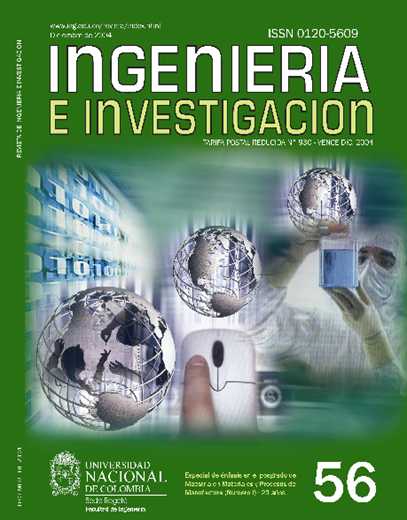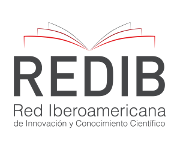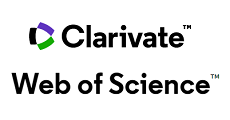Ethanol dehydration
Deshidratación del etanol
DOI:
https://doi.org/10.15446/ing.investig.v24n3.14610Keywords:
ethanol dehydration, extractive distillation, azeotropic distillation, molecular screening (en)deshidratación del etanol, destilación extractiva, destilación azeotrópica, tamices moleculares (es)
Downloads
This review outlines ethanol dehydration processes and their most important characteristics. It also deals with the main operating variables and some criteria used in designing the separation scheme. A differentiation is made between processes involving liquid-steam balance in separation operations and those doing it by screening the difference in molecule size. The last part presents a comparison between the three main industrial processes, stressing their strengths and weaknesses from the operational, energy consumption and industrial services points of view.
El objetivo de esta revisión es presentar los procesos de deshidratación del etanol y sus características más importantes, además de las principales variables de operación y algunos criterios utilizados en el diseño del esquema de separación. Se ha hecho una diferenciación entre los procesos que involucran operaciones equilibrio liquido-vapor para la separación y aquellos que lo hacen a través de diferencias de tamaño molecular. Finalmente, se presenta una comparación de los tres principales procesos aplicados a nivel industrial, resaltando sus fortalezas y debilidades desde el punto de vista operativo, de consumo energético y de servicios industriales.
References
Black, C., “Distillation Modeling of Ethanol Recovery and Dehydration Processes for Ethanol and Gasohol”, Chemical Engineering Progress, Vol. 76, pp. 78-85, 1980.
Powers, et. al., “The Transport and Fate of Ethanol and BTEX in Groundwater Contaminated by Gasohol”, Critical Reviews in Environmental Science and Technology, Vol. 31, No. 1, pp. 79-86, 2001. DOI: https://doi.org/10.1080/20016491089181
Pham, H. and Doherty, M. “Design and Synthesis of Heterogeneous Azeotropic Distillations -II. Residue Curve Maps”, Chemical Engineering Science, Vol. 45, No. 7, pp. 1837-1843, 1990. DOI: https://doi.org/10.1016/0009-2509(90)87059-2
Perry, R., “Perry’s Chemical Engineering”, 7ed, United States of America, Mc Graw-Hill, pp.13-56 — 13-81, 1992.
Pinto, R.T.P; Wolf-Maciel, M.R. y Lintomen, L., “Saline Extractive Distillation Process for Ethanol Purification”, Computers & Chemical Engineering, Vol. 24, pp. 1689-1694, 2000. DOI: https://doi.org/10.1016/S0098-1354(00)00455-5
K-Engineering, Inc., “Dehydrate Ethanol Without Distillation” Chemical Engineering, p. 155, (Oct. 1993),
Doherty, M. F. y Malone, M. F, “Conceptual Design of Distillation Systems”, McGraw-Hill, pp. 186-210 y 359-380, 1995.
Stupiello, J., “Aspectos técnicos para tener en cuenta en las etapas de fermentación y destilación en la producción de alcohol”, Memorias Seminario Internacional de Alcohol Carburante, Cali, Colombia. junio de 2003.
Kosuge, H. y Mortaheb, H., “Simulation and Optimization of Heterogeneous Azeotropic Distillation Process with a Rate-Based Model”, Chemical Engineering and Processing, Vol. 43, pp. 317-326, 2004. DOI: https://doi.org/10.1016/S0255-2701(03)00131-4
Black, C. y Distler, D., “Dehydration of Aqueous Ethanol Mixtures by Extractive Distillation”, Extractive and azeotropic distillation, Advances in chemistry series, Vol. 115, pp. 1-15, 1972. DOI: https://doi.org/10.1021/ba-1972-0115.ch001
Meirelles, A., “Ethanol Dehydration by Extractive Distillation”, Journal Chemistry and Tech Biotechnology, Vol. 53, pp.181-188, 1992. DOI: https://doi.org/10.1002/jctb.280530213
Gavlin, G. et al., “Glycol solvents and method thereof”, United States Patent, 5,853,458, Dec. 1998.
Gavlin, G. et al., “Glycol solvents and process”, United States Patent, 6,177,597, Jan. 2001
Lee, F y Pahl, Robert H., “Solvent Screening Study and Conceptual Extractive Distillation Process to Produce Anhydrous Ethanol from Fermentation Broth”, Industrial Engineering Process Des. Dev, Vol. 24, pp. 168-172, 1985. DOI: https://doi.org/10.1021/i200028a029
Zudkevitch, et al., “Extraction and/or extractive distillation of low molecular weight alcohols from aqueous solutions”, United States Patent, (Jan. 1984), 4.428.798.
Nieuwoudt, et al., “Separation of ethanol mixtures by extractive distillation”, United States Patent, 6.375.807, Apr. 2002.
Hanson, N, Lynn y Scott, D., “Multieffect Extractive Distillation for Separating Aqueous Azeotropes”, Industrial Engineering Chemical Process Des. Dev., Vol. 25, pp. 936-941, 1988. DOI: https://doi.org/10.1021/i200035a017
Uyazan, A., y Gil, I., “Simulación de la deshidratación de etanol azeotrópico por destilación extractiva”, Tesis presentada a la Universidad Nacional de Colombia, para optar al título de “ingeniero químico”, 2003.
Barba, D., Brandani, V. y Di Giacomo, G, “Hyperazeotropic Ethanol Salted-Out by Extractive Distillation. Theorical Evaluation and Experimental Check”, Chemical Engineering Science, Vol. 40, No. 12, pp. 2287-2292, 1985 DOI: https://doi.org/10.1016/0009-2509(85)85130-7
Ligero, E.L., y Ravagnani, T.M.K., “Dehydration of Ethanol with Salt Extractive Distillation — A Comparative Analysis Between Processes with Salt Recovery”, Chemical Engineering and Processing, Vol. 42, pp. 543-552, 2003. DOI: https://doi.org/10.1016/S0255-2701(02)00075-2
Llano, M., y Aguilar, J., “Modeling and Simulation of Saline Extractive Distillation Columns for the Production of Absolute Ethanol”, Computers and Chemical Engineering, Vol. 27, No. 4, pp. 527-549, 2003. DOI: https://doi.org/10.1016/S0098-1354(02)00215-6
Ronggi, Z. y Zhanting, D., “Extractive Distillation with Salt in Solvent”, Tsinghua University, Science and Technology, 1999.
Zhigang, L., Hongyou, W., Ronggi, Z. y. Zhanting, D, “Influence of Salt Added to Solvent on Extractive Distillation”, Chemical Engineering Journal, Vol. 87, pp. 149-156, 2002. DOI: https://doi.org/10.1016/S1385-8947(01)00211-X
Carmo, M. J. y Gubulin, J. C., “Ethanol-Water Adsorption on Commercial 3A Zeolites: Kinetic and Thermodynamic data”, Brazilian Journal of Chemical Engineering, Vol. 14, No. 3, 1997 DOI: https://doi.org/10.1590/S0104-66321997000300004
Jacques, K. Lyons, T. and Kelsall, D. “The Alcohol Textbook”, 3rd edition, Nottingham University Press, Chapters 17 and 19, 1999.
Ulrich, S. Pavel, S. “Design and Operation of a Pervaporation Plant for Ethanol Dehydration”. Journal of Membrane Science. Vol. 36, pp. 463-475, 1988. DOI: https://doi.org/10.1016/0376-7388(88)80036-X
Hömmerich, U. y Rautenbach, R., “Design and Optimization of Combined Pervaporation/Distillation Processes for The Production of MTBE”, Journal of Membrane Science, Vol. 146, pp. 53-64, 1998. DOI: https://doi.org/10.1016/S0376-7388(98)00085-4
Lee, K. et al., “Dehydration of Ethanol/Water Mixtures by Pervaporation with Composite Membranes of Polyacrylic Acid and Plasma-Treated Polycarbonate”, Journal of Membrane Science, Vol. 164, pp. 13-23, 2000. DOI: https://doi.org/10.1016/S0376-7388(99)00097-6
Szitkai, Z.; Lelkes, Z.; Rev, E. y Fonyo, Z., “Optimization of Hybrid Ethanol Dehydration Systems”, Chemical Engineering and Processing, Vol. 41, pp. 631-646, 2002. DOI: https://doi.org/10.1016/S0255-2701(01)00192-1
Chianese, A. y Zinnamosca, F. “Ethanol Dehydration by Azeotropic Distillation with Mixed Solvent Entrainer”, The Chemical Engineering Journal, Vol. 43, pp. 59-65, 1990. DOI: https://doi.org/10.1016/0300-9467(90)80001-S
Brusis, D. y Stichlmair, J, “Determination of the Optimal Entrainer for Azeotropic Distillation by Rigorous MINLP-Optimization”, 6th World Congress of Chemical Engineering, Melbourne, Australia, 23-27 September 2001.
Tsuyumoto, M., Teramoto, A., y Meares, P, “Dehydration of Ethanol on a Pilot Plant Scale, Using a New Type of Hollow-Fiber Membrane”, Journal of Membrane Science, Vol. 133, pp. 83-94, 1997. DOI: https://doi.org/10.1016/S0376-7388(97)00090-2
Changluo, Z., Moe y L and Wei, X., “Separation of Ethanol-Water Mixtures by Pervaporation-Membrane Separation Process”, Desalination, Vol. 62, pp. 299-313, 1987. DOI: https://doi.org/10.1016/0011-9164(87)87031-5
Kraetz, L., “Dehydration of Alcohol Fuels by Pervaporation”, Desalination, Vol. 70, pp. 481-485, 1988. DOI: https://doi.org/10.1016/0011-9164(88)85075-6
Furter, W., “Extractive Distillation by Salt Effect”, Chemical Engineering Communications, Vol. 116, pp. 35-40, 1992. DOI: https://doi.org/10.1080/00986449208936042
Gurmukh, D., “Comparison of Membrane Processes with Distillation for Alcohol/Water Separation”, Journal of membrane science, Vol. 12, pp. 1-26, 1982. DOI: https://doi.org/10.1016/0376-7388(82)80001-X
Lee, et al., “Dehydration of Alcohol with Extractive Distillation”, United States Patent, 4,559,109, Dec. 1985
Schmit, D. y Vogelpohl, A.., “Distillation of Ethanol-Water Solutions in the Presence of Potassium Acetate”, Separation science and technology, Vol. 18, No. 6, pp. 547-554, 1983. DOI: https://doi.org/10.1080/01496398308060293
How to Cite
APA
ACM
ACS
ABNT
Chicago
Harvard
IEEE
MLA
Turabian
Vancouver
Download Citation
CrossRef Cited-by
1. Sergio H. Duque, Carlos A. Cardona, Jonathan Moncada. (2015). Techno-Economic and Environmental Analysis of Ethanol Production from 10 Agroindustrial Residues in Colombia. Energy & Fuels, 29(2), p.775. https://doi.org/10.1021/ef5019274.
2. Rouf Ahmad Bhat, Dig Vijay Singh, Fernanda Maria Policarpo Tonelli, Khalid Rehman Hakeem. (2022). Plant and Algae Biomass. , p.51. https://doi.org/10.1007/978-3-030-94074-4_4.
3. Yeney Lauzurique-Guerra, Lourdes Zumalacárregui-de Cárdenas, Osney Pérez-Ones, Geli Molina-Rivero. (2017). Evaluación de técnicas de deshidratación de etanol aplicando la simulación. DYNA, 84(200), p.185. https://doi.org/10.15446/dyna.v84n200.54230.
Dimensions
PlumX
Article abstract page views
Downloads
License
Copyright (c) 2004 Ana María Uyazán, Iván Dario Gil, J L Aguilar, Gerardo Rodríguez Niño, Luis Alfonso Caicedo

This work is licensed under a Creative Commons Attribution 4.0 International License.
The authors or holders of the copyright for each article hereby confer exclusive, limited and free authorization on the Universidad Nacional de Colombia's journal Ingeniería e Investigación concerning the aforementioned article which, once it has been evaluated and approved, will be submitted for publication, in line with the following items:
1. The version which has been corrected according to the evaluators' suggestions will be remitted and it will be made clear whether the aforementioned article is an unedited document regarding which the rights to be authorized are held and total responsibility will be assumed by the authors for the content of the work being submitted to Ingeniería e Investigación, the Universidad Nacional de Colombia and third-parties;
2. The authorization conferred on the journal will come into force from the date on which it is included in the respective volume and issue of Ingeniería e Investigación in the Open Journal Systems and on the journal's main page (https://revistas.unal.edu.co/index.php/ingeinv), as well as in different databases and indices in which the publication is indexed;
3. The authors authorize the Universidad Nacional de Colombia's journal Ingeniería e Investigación to publish the document in whatever required format (printed, digital, electronic or whatsoever known or yet to be discovered form) and authorize Ingeniería e Investigación to include the work in any indices and/or search engines deemed necessary for promoting its diffusion;
4. The authors accept that such authorization is given free of charge and they, therefore, waive any right to receive remuneration from the publication, distribution, public communication and any use whatsoever referred to in the terms of this authorization.




























